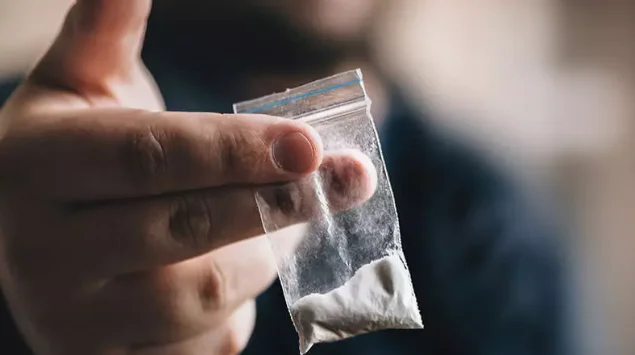
What Is “Freebasing” Cocaine?
Freebase cocaine is a dangerous and much more potent version of cocaine.
Freebasing cocaine is a method of preparing the drug for consumption that involves chemically altering its form to make it more potent and volatile. In this process, cocaine hydrochloride (powdered cocaine) is converted into a base form known as “freebase.”
This process typically involves mixing cocaine hydrochloride with a strong alkaline substance, such as baking soda or ammonia, and then heating it to remove the hydrochloride, leaving behind the freebase cocaine. The substance left over is a solid form of the drug that is usually smoked. This solid substance is known as “crack cocaine” or “crack.”
Freebase cocaine isolates the substance from additives found in the powdered form of the drug. This then results in an almost entirely pure form of cocaine. Cocaine in its purest form is potent, highly addictive, and dangerous.
Why Do People Freebase Cocaine?
Cocaine is a highly addictive drug that leads to the development of tolerance and dependence. The longer people use cocaine, the higher their tolerance gets, and the less sensitive they become to the effects of the drug. As a result, users often begin using cocaine in other ways, such as injecting it or smoking it. However, it is challenging to smoke the powdered form of cocaine because it simply melts.
Freebasing cocaine involves stripping away the chemical additives from cocaine, leaving behind a purer form of the drug known as freebase. This form has a lower melting point, making it suitable for smoking.
When a substance is smoked, its effects are felt rapidly due to the direct delivery to the bloodstream via the lungs. This also applies to smoking freebase cocaine. For individuals struggling with cocaine addiction who are seeking a rapid high, freebasing may seem appealing. However, it’s crucial to recognize the significant dangers associated with this method of use, including a higher risk of dependence and addiction, overdose, and the potential for accidents or explosions during the preparation process.
What are the Effects of Freebase Cocaine?
Smoking freebase cocaine produces an immediate and intense euphoric rush. The high is short-lived, typically lasting less than 30 minutes. This quick onset and intense high contribute to its addictive potential.
Effects of freebasing cocaine include:
- Increased heart rate
- Elevated blood pressure
- Dilated pupils
- Loss of appetite
- Insomnia
- Agitation
- Paranoia
- Anxiety
- Restlessness
- Tremors
- Nausea
- Irregular heartbeat
- Seizures
- Stroke
- Cardiac arrest
However, the comedown phase that follows is longer-lasting and unpleasant, often reversing any positive effects experienced during the high.
Symptoms of a cocaine comedown include:
- Anxiety
- Fatigue
- Irritability
- Paranoia
- Depression
Many people try to avoid the comedown by binging on cocaine, using large amounts of it over a short period. Cocaine binges have a high potential for overdose and other adverse health risks.
Long-Term Effects of Cocaine Abuse & Freebasing
Cocaine abuse can have numerous long-term effects on the mind and body.
Physical Health Problems
Potential long-term effects of cocaine abuse on the body are:
- Cardiovascular issues – Cocaine abuse can lead to heart problems such as heart attacks, arrhythmias, and hypertension.
- Respiratory complications – Smoking crack cocaine can damage the lungs and respiratory system, leading to chronic coughing, respiratory infections, and potentially lung damage.
- Gastrointestinal issues – Chronic use may result in gastrointestinal problems like abdominal pain, nausea, and appetite loss.
- Neurological damage – Prolonged use can cause neurological impairments, including seizures, headaches, and strokes.
- Sexual dysfunction – Long-term use may lead to sexual dysfunction and reproductive issues in both men and women.
Abusing cocaine for an extended amount of time can also damage nerves, affecting movement, and may even lead to Parkinson’s disease.
Mental Health Problems
Cocaine addiction may increase the risk of mental and cognitive health problems, such as:
- Poor cognitive function
- Memory problems
- Poor attention span
- Depression
- Anxiety
- Paranoia
- Psychosis
- Societal and occupational problems
- Poor decision-making skills
Physical Dependence and Addiction
The National Institute on Drug Abuse (NIDA) explains, “Repeated use of cocaine can cause long-term changes in the brain’s reward circuit and other brain systems, which may lead to addiction.”
Cocaine addiction alters how the brain processes feelings of pleasure, known as reward. Frequent cocaine abuse leads to an excessive buildup of dopamine in the brain. Over time, the brain adjusts to this surge and becomes less responsive to the drug’s effects. This means that individuals may develop a tolerance, requiring higher doses to achieve the same high.
Because the brain associates the initial intense rush with pleasure, it craves that sensation. These cravings can become overwhelming, interfering with daily life. Addiction becomes all-consuming, as individuals constantly seek ways to satisfy and alleviate these cravings. Dependency dominates emotional and mental well-being, clouding thoughts and impairing judgment.
When attempts are made to quit using cocaine or when access to the drug is restricted, withdrawal symptoms appear.
Cocaine withdrawal symptoms include:
- Anxiety
- Insomnia
- Muscle pain
- Thoughts of self-harm
- Unpleasant dreams
- Slowed thought process
- Suicidal thoughts
- Depression
- Fatigue
To avoid the painful process of withdrawal, those who are addicted may begin taking more frequent and/or higher doses. This can lead to overdose, which can end up being fatal.
Risks Of Cocaine Overdose
A cocaine overdose occurs when someone takes too much cocaine for their body to handle, resulting in organs to begin shutting down. When switching to smoking freebase, the user may take way too much the first time because they’re not aware of how significant the effects are.
Additionally, freebase cocaine is both pure and smoked. It’s able to cross the blood-brain barrier faster than it would if it were smoked. As a result, freebasing allows people to feel stronger effects more quickly which increases the risk of overdosing.
Symptoms of cocaine overdose include:
- Chest pain
- Irregular heartbeat
- High blood pressure
- Rapid breathing
- Agitation
- Confusion
- Tremors
- Seizures
- Nausea
- Vomiting
- Headache
- Fever
- Sweating
- Blurred vision
- Hallucinations
Overdose is a medical emergency which means it must be treated as such. Even if the overdose is not fatal, it can result in various health risks and life-threatening conditions such as:
- Irregular heart rhythm
- Heart attacks
- Seizures
- Strokes
- Respiratory problems
Cocaine Abuse And Addiction Statistics
The United States has been experiencing an opioid crisis for decades now. But in recent years, national rates of cocaine use have increased, too.
The U.S. Centers for Disease Control and Prevention’s National Center for Health Statistics states that the number of overdose deaths involving cocaine almost doubled in two years — jumping from 5,892 in 2014 to 11,316 in 2016.
According to the Drug Enforcement Administration’s 2018 National Drug Threat Assessment, the rise in cocaine use is partly due to its rise in accessibility.
“Record levels of coca cultivation and cocaine production in Colombia, the primary source for cocaine seized and tested in the United States, has widened the cocaine market, leading to increased domestic abuse,” the report explains.
Treatment For Cocaine Abuse
There are currently no specific medications available for the treatment of cocaine abuse. However, a comprehensive rehab program can help individuals recover. Cocaine addiction treatment involves:
- Comprehensive assessment
- Individualized treatment planning
- Medical cocaine detox
- Inpatient or outpatient rehab
- Behavioral therapy
- Holistic therapies
- Group counseling
- Individual therapy
- Family therapy
- Case management
- Aftercare services
Find Help for Cocaine Addiction today
First Step Behavioral Health is a leading provider of cocaine addiction treatment in South Florida. Our programs can help pull you or your loved one out of the habit of cocaine abuse and into a new, much healthier lifestyle.
Contact us today and let us help you or a loved one begin the road to recovery.

